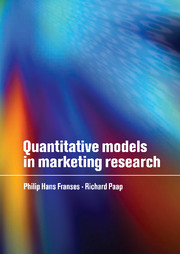Book contents
- Frontmatter
- Contents
- List of figures
- List of tables
- Preface
- 1 Introduction and outline of the book
- 2 Features of marketing research data
- 3 A continuous dependent variable
- 4 A binomial dependent variable
- 5 An unordered multinomial dependent variable
- 6 An ordered multinomial dependent variable
- 7 A limited dependent variable
- 8 A duration dependent variable
- Appendix
- Bibliography
- Author index
- Subject index
7 - A limited dependent variable
Published online by Cambridge University Press: 06 July 2010
- Frontmatter
- Contents
- List of figures
- List of tables
- Preface
- 1 Introduction and outline of the book
- 2 Features of marketing research data
- 3 A continuous dependent variable
- 4 A binomial dependent variable
- 5 An unordered multinomial dependent variable
- 6 An ordered multinomial dependent variable
- 7 A limited dependent variable
- 8 A duration dependent variable
- Appendix
- Bibliography
- Author index
- Subject index
Summary
In chapter 3 we considered the standard Linear Regression model, where the dependent variable is a continuous random variable. The model assumes that we observe all values of this dependent variable, in the sense that there are no missing observations. Sometimes, however, this is not the case. For example, one may have observations on expenditures of households in relation to regular shopping trips. This implies that one observes only expenditures that exceed, say, $10 because shopping trips with expenditures of less than $10 are not registered. In this case we call expenditure a truncated variable, where truncation occurs at $10. Another example concerns the profits of stores, where losses (that is, negative profits) are perhaps not observed. The profit variable is then also a truncated variable, where the point of truncation is now equal to 0. The standard Regression model in chapter 3 cannot be used to correlate a truncated dependent variable with explanatory variables because it does not directly take into account the truncation. In fact, one should consider the so-called Truncated Regression model.
In marketing research it can also occur that a dependent variable is censored. For example, if one is interested in the demand for theater tickets, one usually observes only the number of tickets actually sold. If, however, the theater is sold out, the actual demand may be larger than the maximum capacity of the theater, but we observe only the maximum capacity. Hence, the dependent variable is either smaller than the maximum capacity or equal to the maximum capacity of the theater. Such a variable is called censored. Another example concerns the donation behavior of individuals to charity.
- Type
- Chapter
- Information
- Quantitative Models in Marketing Research , pp. 133 - 157Publisher: Cambridge University PressPrint publication year: 2001



